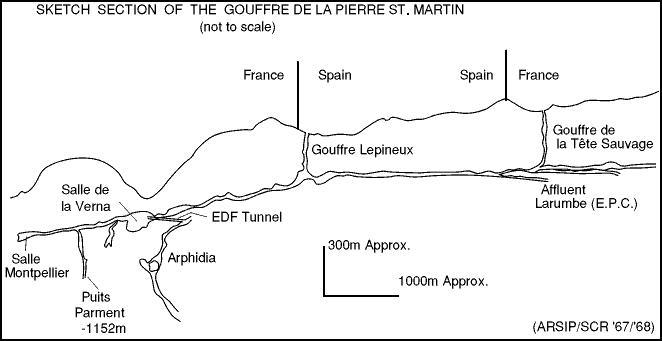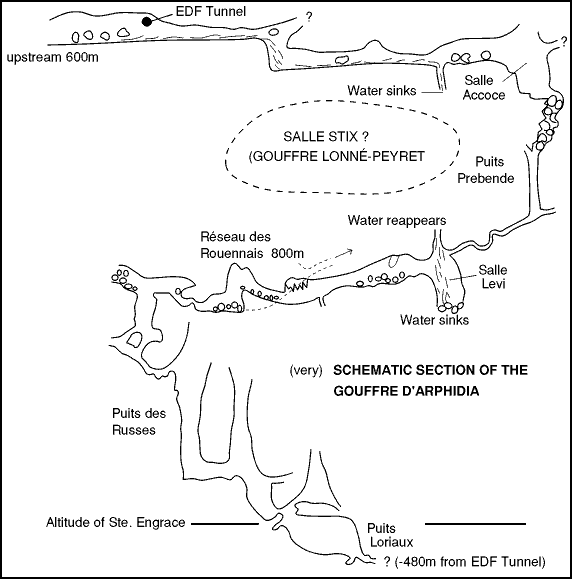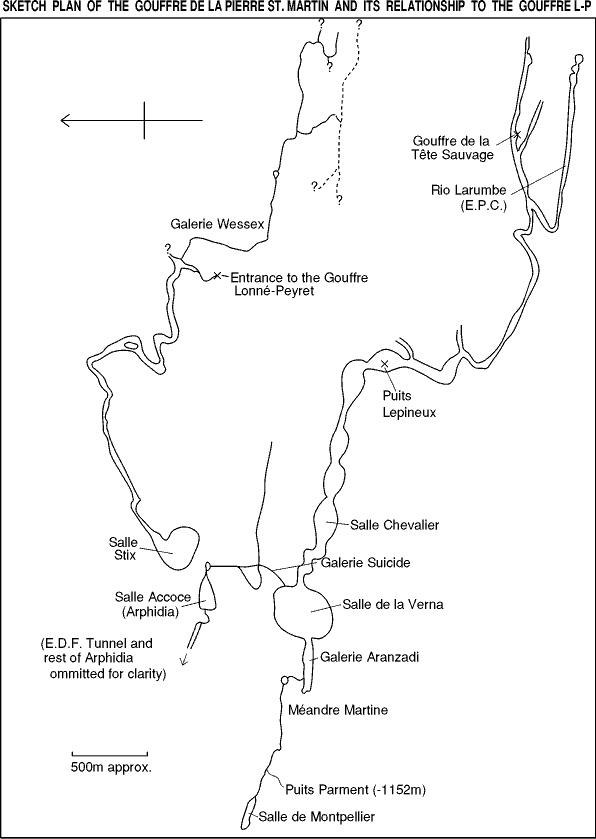
| CUCC Home | ||
|---|---|---|
| Previous: Half a Century on |
CU 1972 Contents Page | Next: The Cam-Block |
C.U.C.C.'s interest in the world's deepest cave, the Gouffre de la Pierre St. Martin, and the surrounding area, dates from the Easter of 1970 when Nick Reckert visited the Réseau d'Arphidia as a member of the Spéléo-Club de Rouen. In the course of a three-day bivouac in this important system, an 800 metre extension, the Réseau de la Pucelle, was deflowered, the team turning back because of lack of time. This system consisted of a largely dry passage, but water was met towards the end. Since the hydrology of Arphidia is still dubious, this could be of considerable importance.
He returned in the summer to the A.R.S.I.P. fixed camp near the Gouffre de la Tête Sauvage. Attempts near here to find a still higher entrance to the P.S.M. resulted in the discovery of a pot known as M2 situated some 150m higher than the Tête Sauvage in the barren lapiaz. A Kilometre of pitches was descended in this rift-dominated system, but the greatest depth achieved was only 250m, at which point the pot degenerated into tight rifts. However, it is almost certain that M2 will reach the three big chambers at the top of the Affluent Larumbe, pushed in 1969 by the Eldon P.C. One of the more sporting points of this pot is its extreme looseness; you literally have to race the belay points to the bottom!

The most important discovery, however, was the Gouffre Lonné-Peyret, named after the Mayor of the neighbouring village of Arette. The presence of a large drainage had long been suspected to the north of the Pierre, and running roughly parallel to it. M. Ravier, the French hydrologist who predicted the existence of this system had provisionally named it Arrigoyena, (The Black Ravine) after its presumed resurgence near the village of Ste. Engrace. A small party, including Nick, from the Tête Sauvage camp went prospecting in this area and had the good fortune to discover a large series of pitches which were soon found to lead into a big river. A three-day trip into the system pushed its depth to about 600m before the team was forced to turn back for lack of time.
In Easter 1971, the pot was followed to a depth of 717m, ending in a large chamber, the Salle Stix, where the water sank uncompromisingly.
The summer of 1971 was not very productive, partly because the A.R.S.I.P. camp had to be cancelled and partly because of the tragic death of Félix Arcaute in the upstream section of the Lonné-Peyret, the Galerie Wessex. The few French cavers who were around, notably a group from Bordeaux, were occupied over the border at Anialara, looking for the Rivière St. Georges. A couple of half-hearted British expeditions, including a miniature one from C.U.C.C., did little more than get to know the area. Our own activities at the Pierre are described in the Expedition log elsewhere in this Journal.
If one considers in more detail the hydrological complexities of the area, it becomes apparent that there is still a tremendous amount to be found and many connections to be made. Some time ago, that well known Speleologist and Philosopher, Norb Casteret, pontificating in Spelunca, the journal of the Fédération Française de Spéléologie, wrote that the Pierre was as deep as it was ever going to be; it was then 845m deep. It is now 1152m deep and there is every prospect of its going still deeper. Enough said. In the upstream section, the M2 connection, when established, will bring the depth to 1300m, and the lower reaches are still extremely promising. It is very unlikely that any extension will be found at the bottom of the lowest known pitch in the Pierre, the Puits Parment, since any passages found at this depth are certain to be immature, having been formed only recently, since the Galerie Aranzadi was abandoned. Moreover, these passages will very probably be blocked by debris from the Verna. At the moment the hope seems to lie in the Salle Ballandraux: this is a large chamber with a strongly draughting boulder choke and lies sufficiently far away from the Verna to stand a good chance of either; rejoining the abandoned course of the main stream beyond the mud choke in the Galerie Aranzadi; or continuing horizontally, becoming more mature as it receives inlets until it finally hits a series of pitches. It seems improbable that the active streamway of the Pierre will be vadose at this depth, or if so, it is likely to be interspersed with many sumps.
It seems likely, on the other hand, that a natural connection will be found with Arphidia. At present, this very important system is only linked to the Pierre by the EDF Tunnel, but when a natural connection is found, it will add approximately another 200m to the depth of the latter. Surveys show that the Galerie Suicide in the upstream part of Arphidia runs very close to the Salle de la Verna. Ruben Gomez, who discovered this inlet whilst looking for somewhere to satisfy the importunings of nature, is, to date, the only person to have visited this passage. He reports that it ends in impenetrable squeezes between huge flakes of rock. Still, Ruben is not the smallest of men, and a ferret, or better still, a professional thin man, might be able to force his way through to the Salle de la Verna, or the Salle Chevalier, comfortably breaking the world depth record.
The main system of Arphidia still remains something of a mystery. The water which sinks before the Salle Accoce is not seen again until it reappears as a waterfall in the roof of the Salle Levi. It sinks again in the boulders at the bottom of this chamber and is not seen again, although the known pot goes down for a further 250m. Like that of the Pierre, this water resurges at the Source de la Bentia, but what happens between the Salle Levi and there ? The best bet would seem to be a search for parallel pitches which might find the water, but this could be pretty unrewarding. Alternatively, one could attempt to follow the Réseau de la Pucelle, since, at the final point reached, inlets were entering everywhere, and by following the water it might be possible to by-pass the blockage in the Salle Levi. Whatever the case, there is still a great amount of promise in this enormously complex system.

This was originally thought to be the entrance to the conjectured parallel system to the Pierre, (the Rivière d'Arrigoyena) and was presumed to follow the course of a well-defined surface valley to a resurgence near Ste. Engrace. However, dye-tests made in 1971 proved, to French surprise, that it drained to the Source de la Bentia, the shared resurgence of the Pierre and Arphidia. Clearly, therefore, the drainage of the area is even more complex than had been proposed. The Lonneé-Peyret stream heads almost due west, and a recent French survey reveals that the lowest point reached, the Salle Stix, is only a matter of metres from the Salle Accoce in Arphidia. It seems absolutely certain that the Lonneé-Peyret water joins the Arphidia stream only a short distance further on - certainly before the Arphidia water joins the main stream of the Pierre. Moreover, if the elevation of the French survey is correct, the Lonneé-Peyret stream could join the Arphidia water between its sink above the Salle Accoce and its re-emergence in the roof of the Salle Levi. Since, at the time of the dye-test no-one suspected the proximity of the two systems, there was no attempt made to look for traces in Arphidia itself. Furthermore, Nick has the impression (though he admits that he may well be up his leg) that the volume of water falling into the Salle Levi may be greater than that met on the 20m pitch before the stream sinks - this could be explained by the Lonneé-Peyret water. Certainly, the passage section below the Salle Levi is larger than that above and this would fit into the hypothesis that the two streams once flowed together down the now abandoned passages which form the continuation of Arphidia, before creating the present sink in the Salle Levi. This sink is some thirty metres below the entrance to the fossil passages, implying that these have been abandoned for a long time, since the upstream passages, although still active, are so much smaller than the lower ones, it appears extremely unlikely that such large tunnels as the Galérie Unamuno could have been formed by the same, single, small stream. Clearly, more dye-testing is required and also a more accurate survey of Lonneé-Peyret. At all events a connection between Lonneé-Peyret and Arphidia seems imminent and digging in the Salle Accoce could produce exciting results. During a trip down Arphidia last summer a C.U.C.C. party, accompanied by a couple of members of U.L.S.A., inspected a small, draughting hole in this chamber. It was heading in the right direction, and was taking some water, although it had obviously taken a lot more in the past. Unfortunately, lack of time and manpower prevented any serious excavation.
Meanwhile the future of Lonneé-Peyret is looking very rosy, in that the cave bears a great resemblance to the Pierre. The similarities are obvious: in the Pierre, a large pitch, the Puits Lepineux, leads to the main cave. Upstream there are active canals, downstream large, semi-abandoned passages ending in a chamber where the stream sinks. In the Gouffre Lonneé-Peyret, a series of big pitches (the first is 125m deep) leads to the main system. Upstream, the Galérie Wessex, are active canals, downstream, large semi-abandoned passages leading to a large chamber, the Salle Stix. Bearing in mind these similarities, it is likely that a top entrance, comparable to the Tête Sauvage entrance to the Pierre, will be found. Indeed, prospecting has already been started in the Arres Planère to the south of the Ski-Station. Assuming this, and a connection with Arphidia, the world depth record goes yet again. If one wants to indulge in still more flights of fancy, one can have considerable amusement in censidering a through trip from M2 to the upstream end of Lonneé-Peyret!!!
It might be worth mentioning that the Spéléo-Club de Dreux are at present pushing an interesting little pot (now a mere 250m deep) known as BT6, which is certain to join up with the Lonneé-Peyret streamway, although it will establish no new records. This pot is a rarity in that it seems to have got lost en route to Yorkshire, being tight wet and very sporting.

There remains the task of finding the system which the Lonneé- Peyret was originally thought to be. Since the discovery of this system, it has become obvious that the water-shed of Arrigoyena is much smaller than had been imagined. Consequently, although this system will be very deep, it will be much tighter and thrutchier than either the Pierre or Lonneé-Peyret. The dry valley which had initially led people to assume that the Lonneé-Peyret stream went down to the Arrigoyena resurgence is joined a short way down by another dry valley below the Soum de Soudet. C.U.C.C. did a little prospecting here, and unearthed a couple of short, choked holes, the deeper being only 20m deep, but this is clearly the right area. If the system follows the PSM/L-P pattern, there should be a top entrance to the north of the Arres Planère and to the east of Les Bourugues. While prospecting there in August of last year, we stumbled across a 100m shaft, C.U.C.C. 3, in the bed of a very deep, dry valley. Unfortunately, it also sounded very unstable, so it could well be choked. With only two of us, and the weather conditions very bad, the prospect was not encouraging and we had to leave without closer examination. However, this area will definitely repay investigation in 1972.
The area above this predicted system, Anialara, was the scene of considerable activity last summer by the Spéléo-Club de Bordeaux. This location is in Spain, a huge and absolutely deserted expanse of lapiaz; it took them ten days of solid portaging merely to cart their gear out on to the clints, and for a week or so, they had no joy. Eventually, a break-through of sorts was made, and slight chemical persuasion enabled them to reach a depth of 350m by the end of the summer. They turned back for lack of tackle, estimating that the river was only another 100 m down. The potential depth of the system is at least 1700m, compared with the Pierre's present depth of 1152m, and it seems absolutely certain that if a new world depth record is not established in Persia this year, it will be in the Pyrenees.
Recommended reading for expeditions intending to visit the area of the Pierre St. Martin :-
NICK RECKERT and JONT LEACH.
| CUCC Home | ||
|---|---|---|
| Previous: Half a Century on |
CU 1972 Contents Page | Next: The Cam-Block |